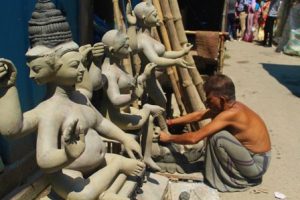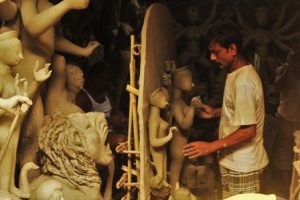Kolkata’s Kumortuli: Where Idols Come to Life
Maa Durga has arrived home. A journey through the lanes of Kumortuli to see the curators of Bengali art and artistry.

It is that time of the year when the city of joy has wrapped itself in a veil of pompous glory and turned into a pot of ecstatic celebrations. The streets are adorned with shimmering lights; the playful rhythm of the dhaak (drum) has blended with the aroma of spring air. Countless people from the country and beyond have come together to celebrate perhaps one of the biggest festivals in India. Devi Durga (or Maa Durga, as fondly addressed by devotees) has arrived home.
Months before the Durga Puja, as the city prepares to welcome the deity, numerous hands at the potter’s quarter of Kolkata relentlessly work day and night to breathe life into the idols of Goddess Durga. Delhi Post recently embarked on a journey through the lanes of Kumortuli to catch the curators of Bengali art and artistry in action. Read on to know all about the potter’s quarter of Kolkata.
The History
Back in the day, the metropolitan city of Kolkata was divided into the villages of Gobindapur, Sutanuti and Kalikata. During the time of British India, the East India Company built Fort William in Gobindapur after the British emerged victorious in the Battle of Plassey in 1757. Now, most of the existing families in the area have moved to Sutanuti. Around the year 1760, the directors of the company ordered the then Governor-General of Bengal, John Holwell, to segregate districts of the area according to the designation and job role of the Company’s workers. Therefore, these localities acquired their names from the different communities of workers that took residence in the area. The locality of winemakers became Suriparah, the area of cowherds became Ahiritola and, similarly, the region of the potters came to be known as Coomartolly (as addressed in the regional language), which was later transformed into the modern-day Kumortuli.
Also Read : Exploring The Remaining Ruins Of Kolkatas China Town
The Location
After the troops of Nawab Sirajud-Daulah invaded the market area of Burrabazar, which was earlier known as Sutanuti Bazar, numerous artisans were evicted from the locality. Over the years, the number of communities decreased and eventually vanished. However, the only surviving group of artisans were the potters of Kumortuli area. Initially, they started making clay pots, figures and statues and moved on to create idols of gods and goddesses. The demand for the idols increased with time and the potters’ community made the area their own workplace.
Today, Kumortuli stands strong as the hub of idol making and figurine artistry of Bengal.
Kumortuli is presently located within KMC Ward No. 9 between Ahiritola and Shobhabazar. Countless shops creating and selling clay idols and statues are situated amidst the narrow lanes of the area.
The Creators

The idol makers of Kumortuli are a bunch of individuals who are constantly engaged and deeply engrossed in their work. Especially in the festive season, constrained by tight deadlines, their usual eight-hour shifts seldom transforms into more than twelve-hour shifts. Multiple working hands spend hours perfecting the 10-hand goddess Durga and her children, alongside their pets and the arch-nemesis Mahishasura. ‘We work day and night to present the idols to various committees. As Lakshmi Puja and Kali Puja fall right after Durga Puja, we even spend the four days of the festival working’, shared idol maker Ramen Pal. ‘By the end of the festive season, we are so tired that it is physically straining to visit the puja pandals ourselves’, he added.
Most of the clay artisans today hail from Krishnanagar in Nadia district of West Bengal. Majority of these idol makers identify their surname as ‘Pal’ that they carry from the origin of their ancestors. ‘Our forefathers have been engaged in idol making since the very beginning of this profession in the city. They started working near about 300 years back bringing in clay from the banks of the Ganga River. Neither the area nor the city was so developed then. Changing times brought in new advancements and simple clay models transformed into life-sized idols that you people see everywhere today. But the work we do involves a lot of hard labour, and I do not want the following generation to take up the same’, said Samir Pal, a renowned idol maker in Kumortuli.
On the other hand, idol artists Santu Pal shared, ‘My great grandfathers have worked in this place and I would definitely want my children to be engaged in idol making too. In fact, one of my sons already works as a potter in Delhi. Though this involves a lot of hard work, whenever we see our idols put up in grand pujas in the city, we feel proud and happy’.
The idol makers have their own sections of workers segmented according to the job role. Some bring clay from the banks of the nearby river, some make the basic structure out of bamboo and straw, some moulds the clay into idols; some are engaged in painting while others design and adorn the dresses and ornaments. During the lean seasons, they often make clay dolls and items to sustain their business. The demand for idols of different god and goddesses, however, are high all around the year for various occasions.
The Idols
The idols in Kumortuliare mostly made out of raw clay and straw. The initial structures of the idols are created with bamboo scaffolds in multiple factories in the area. The formation is then given a base through the binding of straws. Right after it is handed over to the clay artists to mould into figurines, it is then taken up for painting with colours. The final touch is given through the decorations with the ornaments and dresses.
Also Read : Dalit Rap Artiste Smashes Brahminical Caste Structure Weapons His Music
The ornamentation of the idols is of two kinds: sholarshaaj (ornaments made of out milk-white material from shoal trees) and daakershaaj (ornaments made out of silver foils).
The Changing Times
As the years passed by, Kolkata adapted itself to various elements of modernization. The abode of the idols or the potters’ hub of the city was not behind in accepting the changing times and traditions. New methods of painting using modern colouring tools have been included in the process of idol making. Many makers have even adapted designing using fibreglass for ease of assembling the parts. The idols and statues are now transported in various parts of the country.
Earlier, the eyes of goddess Durga were drawn on the day of Mahalaya, which was commonly known as the ritual of ChokkhuDaan. At present, the potters fail to maintain the same due to the need for advanced delivery, high demand and strict deadlines.
Kumortuli now serves as one of the biggest tourist attractions in the city. The area welcomes visitors from all around the world almost every day. However, irrespective of modern changes, the essence of true Bengali art and culture oozes out from the very lanes of Kumortuli. As long as West Bengal celebrates the auspicious occasion of Durga Puja and other similar religious festivals, the idol shop adorned narrow lanes of Kumortuli will be alive in its true light.
